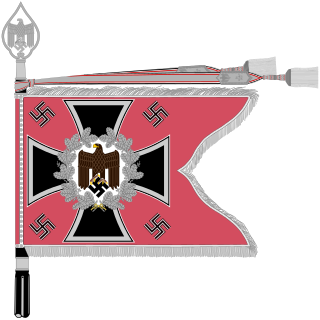Related Research Articles

The German Army is the land component of the armed forces of Germany. The present-day German Army was founded in 1955 as part of the newly formed West German Bundeswehr together with the Marine and the Luftwaffe. As of January 2022, the German Army had a strength of 62,766 soldiers.
The Panzergrenadier Division "Großdeutschland", also commonly referred to simply as Großdeutschland or Großdeutschland Division, was an elite combat unit of the German Army (Heer) that fought on the Eastern Front in World War II.

Panzergrenadier, abbreviated as PzG (WWII) or PzGren (modern), meaning "Armour"-ed fighting vehicle "Grenadier", is a German term for mechanized infantry units of armoured forces who specialize in fighting from and in conjunction with infantry fighting vehicles (IFVs) – that is, armoured troop carriers designed to carry a mechanized squad of six to eight soldiers into combat while providing direct fire support for those troops.
The German 206th Infantry Division, was a military unit that served during World War II. Like most German infantry units it had no motorization, and relied on leg and horse mobility.

A Panzer division was one of the armored (tank) divisions in the army of Nazi Germany during World War II. Panzer divisions were the key element of German success in the blitzkrieg operations of the early years of World War II. Later the Waffen-SS formed its own panzer divisions, and even the Luftwaffe fielded an elite panzer division: the Hermann Göring Division.
The Fallschirm-Panzer-Division 1. Hermann Göring was a German Luftwaffe armoured division. The HG saw action in France, North Africa, Sicily, Italy and on the Eastern Front during World War II. The division began as a battalion-sized police unit in 1933. Over time it grew into a regiment, brigade, division, and finally was combined with the Parachute-Panzergrenadier Division 2 Hermann Göring on 1 May 1944 to form a Panzer corps under the name Reichsmarschall. It surrendered to the Soviet Army near Dresden on 8 May 1945.

The 27th Panzer Division was an incomplete armoured (Panzer) division of the German Wehrmacht during World War II. It began forming in the southern sector of the Eastern Front in late 1942, but was never completed due to the loss of its assets during the Soviet counteroffensives in the Battle of Stalingrad, and no further attempts were made to reconstitute the division.

The 60th Infantry Division was formed in late 1939, from Gruppe Eberhardt, a collection of SA units that had been engaged in the capture of Danzig during the Invasion of Poland. This division was unusual in that its manpower was largely drawn from the SA and the police.

Panzerwaffe, later also Panzertruppe refers to a command within the Heer of the German Wehrmacht, responsible for the affairs of panzer (tank) and motorized forces shortly before and during the Second World War.
XXXXVIII Panzer Corps, was a corps-level formation of the German Army which saw extensive action on both the Eastern and Western Fronts during World War II.

III Army Corps was a corps level formation of the German Army during World War II.
As the number of German troops committed to the North African Campaign of World War II grew from the initial commitment of a small corps, the Germans developed a more elaborate command structure and placed the enlarged Afrika Korps, with Italian units under this new German command and a succession of commands were created to manage Axis forces in Africa:
The XXXIX Panzer Corps was a German panzer corps which saw action on the Western and Eastern Fronts during World War II.
The 3rd Panzer Army was a German armoured formation during World War II, formed from the 3rd Panzer Group on 1 January 1942.

The Führerbegleitbrigade was a German armoured brigade and later an armoured division (Panzer-Führerbegleitdivision), in World War II. It grew out of the original Führer-Begleit-Battalion formed in 1939 to escort and protect Adolf Hitler at the front. It was formed in November 1944 and destroyed in April 1945.

Josef Harpe was a German general during World War II who commanded the 9th Army. He was a recipient of the Knight's Cross of the Iron Cross with Oak Leaves and Swords of Nazi Germany.
XLVII Panzer Corps was a panzer corps of the German Army in World War II that was formerly designated as XLVII Corps. Various formations of the corps fought in the French campaign of 1940, in the invasion of Soviet Union from 1941 to 1944, and on the Western Front from June 1944 until April 1945.
The XXIV Army Corps was a unit of the German Army during World War II. The unit was re-designated several times; originally being Generalkommando der Grenztruppen Saarpfalz, later Generalkommando XXIV. Armeekorps, then XXIV. Armeekorps (mot.) and finally XXIV. Panzerkorps.
The VII Panzer Corps was a panzer corps of Nazi Germany during World War II.
The I Cavalry Corps, initially known simply as the Cavalry Corps, or alternatively as Cavalry Corps Harteneck after its commander, was an army corps of the German Wehrmacht during World War II. It was formed in 1944 and existed until 1945.
References
- ↑ The following list is based on www.lexikonderwehrmacht.de (list is not complete)
- http://www.lexikon-der-wehrmacht.de/Gliederungen/KorpsPz/PzKprps.htm
- http://www.lexikon-der-wehrmacht.de/Gliederungen/KorpsSS/Gliederung.htm
- http://www.lexikon-der-wehrmacht.de/Gliederungen/KorpsSonstige/FallPzKorpsGliederung.htm
- de Beaulieu, Charles 'Der Vorstoss der Panzergruppe 4 auf Leningrad'